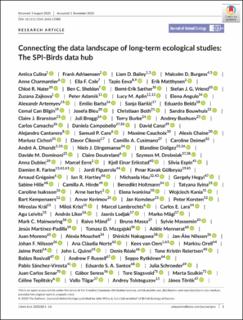| dc.contributor.author | Culina, Antica | |
| dc.contributor.author | Adriaensen, Frank | |
| dc.contributor.author | Bailey, Liam D. | |
| dc.contributor.author | Burgess, Malcolm | |
| dc.contributor.author | Charmantier, Anne | |
| dc.contributor.author | Cole, Ella F | |
| dc.contributor.author | Eeva, Tapio | |
| dc.contributor.author | Matthysen, Erik | |
| dc.contributor.author | Nater, Chloe Rebecca | |
| dc.contributor.author | Sheldon, Ben C. | |
| dc.contributor.author | Sæther, Bernt-Erik | |
| dc.contributor.author | Vriend, Stefan J.G. | |
| dc.contributor.author | Zajkova, Zuzana | |
| dc.contributor.author | Adamik, Peter | |
| dc.contributor.author | Aplin, Lucy M. | |
| dc.contributor.author | Angulo, Elena | |
| dc.contributor.author | Artemyev, Alexandr | |
| dc.contributor.author | Barba, Emilio | |
| dc.contributor.author | Barišić, Sanja | |
| dc.contributor.author | Belda, Eduardo | |
| dc.contributor.author | Bilgin, Cemal Can | |
| dc.contributor.author | Bleu, Josefa | |
| dc.contributor.author | Both, Christiaan | |
| dc.contributor.author | Bouwhuis, Sandra | |
| dc.contributor.author | Branston, Claire J. | |
| dc.contributor.author | Broggi, Juli | |
| dc.contributor.author | Burke, Terry | |
| dc.contributor.author | Bushuev, Andrey | |
| dc.contributor.author | Camacho, Carlos | |
| dc.contributor.author | Campobello, Daniela | |
| dc.contributor.author | Canal, David | |
| dc.contributor.author | Cantarero, Alejandro | |
| dc.contributor.author | Caro, Samuel P. | |
| dc.contributor.author | Chaine, Alexis | |
| dc.contributor.author | Cauchoix, Maxime | |
| dc.contributor.author | Cichoń, Mariusz | |
| dc.contributor.author | Ćiković, Davor | |
| dc.contributor.author | Cusimano, Camillo A. | |
| dc.contributor.author | Deimel, Caroline | |
| dc.contributor.author | Dhondt, André A. | |
| dc.contributor.author | Dingemanse, Niels J. | |
| dc.contributor.author | Doligez, Blandine | |
| dc.contributor.author | Doutrelant, Claire | |
| dc.contributor.author | Drobniak, Szymon M. | |
| dc.contributor.author | Dubiec, Anna | |
| dc.contributor.author | Eens, Marcel | |
| dc.contributor.author | Erikstad, Kjell E | |
| dc.contributor.author | Espín, Silvia | |
| dc.contributor.author | Farine, Damien R. | |
| dc.contributor.author | Mennerat, Adele | |
| dc.date.accessioned | 2021-01-06T07:35:18Z | |
| dc.date.available | 2021-01-06T07:35:18Z | |
| dc.date.created | 2020-12-09T14:44:14Z | |
| dc.date.issued | 2020 | |
| dc.identifier.issn | 0021-8790 | |
| dc.identifier.uri | https://hdl.handle.net/11250/2721613 | |
| dc.description.abstract | The integration and synthesis of the data in different areas of science is drastically slowed and hindered by a lack of standards and networking programmes. Long‐term studies of individually marked animals are not an exception. These studies are especially important as instrumental for understanding evolutionary and ecological processes in the wild. Furthermore, their number and global distribution provides a unique opportunity to assess the generality of patterns and to address broad‐scale global issues (e.g. climate change). To solve data integration issues and enable a new scale of ecological and evolutionary research based on long‐term studies of birds, we have created the SPI‐Birds Network and Database (www.spibirds.org)—a large‐scale initiative that connects data from, and researchers working on, studies of wild populations of individually recognizable (usually ringed) birds. Within year and a half since the establishment, SPI‐Birds has recruited over 120 members, and currently hosts data on almost 1.5 million individual birds collected in 80 populations over 2,000 cumulative years, and counting. SPI‐Birds acts as a data hub and a catalogue of studied populations. It prevents data loss, secures easy data finding, use and integration and thus facilitates collaboration and synthesis. We provide community‐derived data and meta‐data standards and improve data integrity guided by the principles of Findable, Accessible, Interoperable and Reusable (FAIR), and aligned with the existing metadata languages (e.g. ecological meta‐data language). The encouraging community involvement stems from SPI‐Bird's decentralized approach: research groups retain full control over data use and their way of data management, while SPI‐Birds creates tailored pipelines to convert each unique data format into a standard format. We outline the lessons learned, so that other communities (e.g. those working on other taxa) can adapt our successful model. Creating community‐specific hubs (such as ours, COMADRE for animal demography, etc.) will aid much‐needed large‐scale ecological data integration. | en_US |
| dc.language.iso | eng | en_US |
| dc.publisher | Wiley | en_US |
| dc.rights | Navngivelse 4.0 Internasjonal | * |
| dc.rights.uri | http://creativecommons.org/licenses/by/4.0/deed.no | * |
| dc.title | Connecting the data landscape of long‐term ecological studies: The SPI‐Birds data hub | en_US |
| dc.type | Peer reviewed | en_US |
| dc.type | Journal article | en_US |
| dc.description.version | publishedVersion | en_US |
| dc.subject.nsi | VDP::Zoologiske og botaniske fag: 480 | en_US |
| dc.subject.nsi | VDP::Zoology and botany: 480 | en_US |
| dc.source.journal | Journal of Animal Ecology | en_US |
| dc.identifier.doi | 10.1111/1365-2656.13388 | |
| dc.identifier.cristin | 1858014 | |
| dc.relation.project | Norges forskningsråd: 267511 | en_US |
| dc.relation.project | Norges forskningsråd: 223257 | en_US |
| dc.description.localcode | © 2020 The Authors.This is an open access article under the terms of the Creative Commons Attribution License, which permits use, distribution and reproduction in any medium, provided the original work is properly cited. | en_US |
| cristin.ispublished | true | |
| cristin.fulltext | original | |
| cristin.qualitycode | 2 | |

